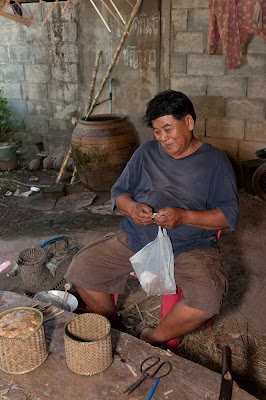 |
| Tahsang Villager and His Weaving Works |
What the people have is a strong sense of family and community. They are survivors; people who know how and have the skills to take advantage of what is available to them. The people are capable of doing many things for themselves and for their families.
I have documented men and women making knives from recycled leaf springs from trucks. Women weaving cotton as well as silk fabric. I have on several occasions documented women weaving reeds to create colorful mats that are used for sleeping on, worshipping on, sitting on as well as eating on. I suspect other activities are done upon the mats, but modesty has prevented me from witnessing them or photographing the activity. I have photographed men weaving fine fishing nets under the shade of a large tree in their yard.
To feed themselves and their families, the people grow rice, garlic, corn, peanuts, sugar cane, cassava, and vegetables. If they do not have land or money to rent land, the people hire out their labor to others. Men as well as women harvest various plants from along the roadside for feeding themselves. People fish the rivers, floodplains, and rivers.
There always is something going on in the villages and along the roadsides.
 |
| Lao Loum Man Making a Kong Kao |
Duang's uncle like many Lao Loum men is very versitile. He is always busy and is always interesting to follow. On our visit to the village he was occupied weaving kong kao. He had cut some hardwood limbs previously and dried them outside his home. Now that the wood was properly aged and dry, he had split it into many thin as well as narrow strips.
 |
| From memory and experience, the bottom pattern is created |
When Lao Loum people go fishing, often with had thrown nets or just with their hands, they place their catch in floating woven fishing creels to keep their catch fresh. The creels are intricately woven objects that are kept afloat by emptied drinking water bottles that are attached on each side.
As I watched the kong kao being woven, I was impressed once again on how the design is in the head of the crafts person. I had marveled at this before with the saht weavers as well as the fabric weavers. The needlepoint and embroidery of the Hill Tribe peoples of Southeast Asia are also from the mind of the crafts person and are not from a blueprint or written specification. We who live in more urban and industrialized societies often lose the sense of how creative the individual mind can be. In the more urban and industrialized societies, our interface with creativity is often limited to an occasional exposure with art however in less "sophisticated" societies creativity is part of everyday life.
 |
| Time for a smoke break - rolling his own |
 |
| Enjoying a few puffs |
After a couple of relaxing puffs, he recommenced his work as he continued to smoke.
One of these days, I will have to learn how to do this. I am sure that he will be pleased to try and teach me. No, not the rolling of your own cigarettes, for I have no need for that. I would like to try to weave a kong kao and perhaps a fishing creel. Most people are willing and happy to pass on knowledge as well as teach a skill. Teaching others adds and strengthens our sense of community.
Teaching others creates a lasting legacy.





